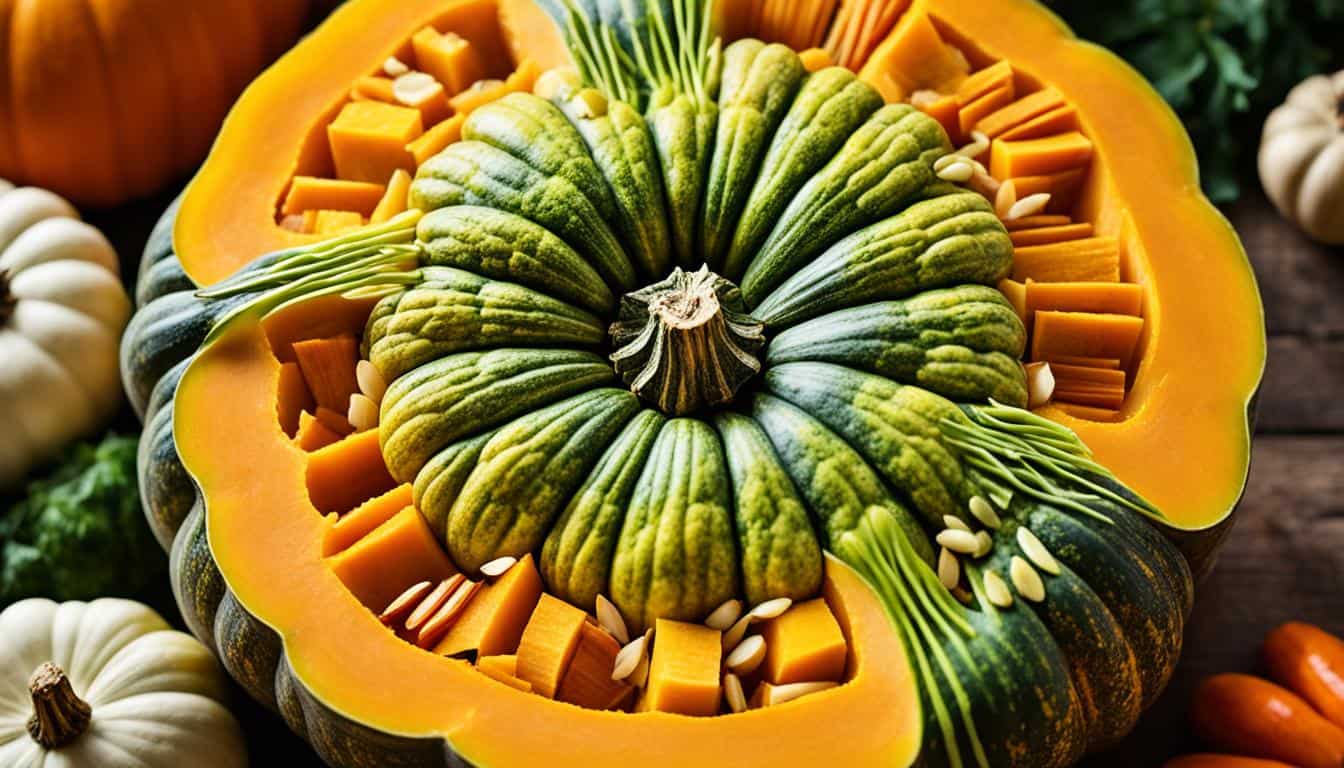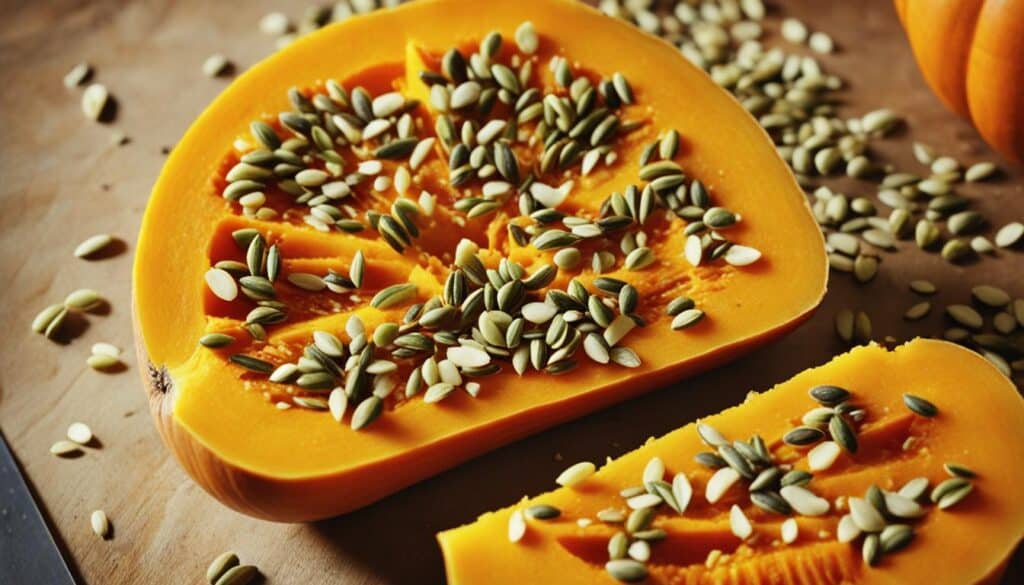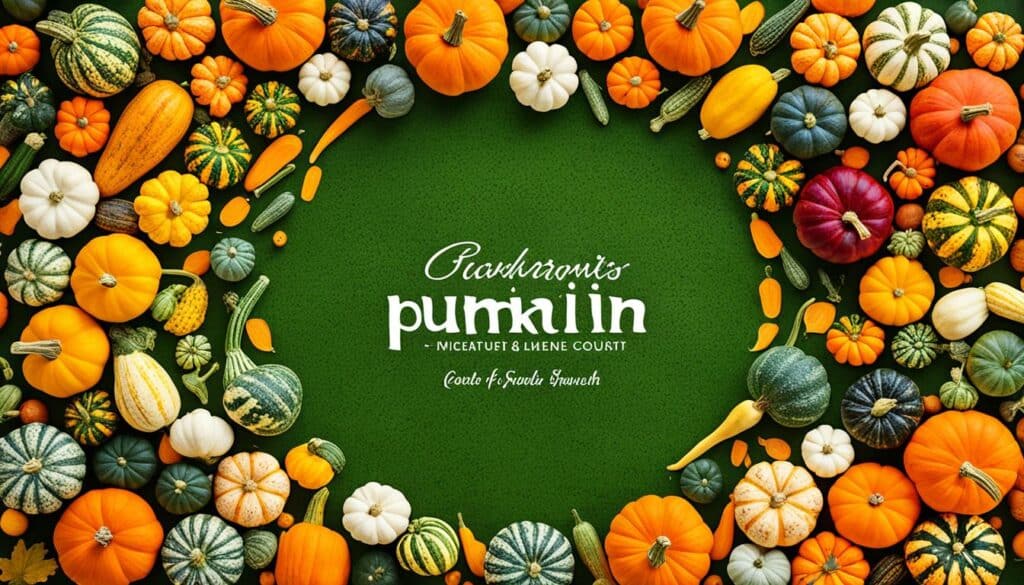Did you know that there are over 50 varieties of pumpkin squash and winter squash? From acorn squash to butternut squash, these delicious and versatile vegetables come in all shapes, sizes, and flavors. While pumpkins are commonly associated with Halloween, they are also edible and can be a delightful addition to your autumnal recipes. Whether you’re looking for cooking tips, health benefits, or even advice on growing your own pumpkin squash, this ultimate guide has got you covered.
Key Takeaways:
- There are over 50 varieties of pumpkin squash and winter squash, each with its own unique taste and texture.
- Pumpkin squash can be roasted, baked, sautéed, or steamed and used in both sweet and savory dishes.
- Pumpkin squash is packed with nutrients, including vitamins A, C, and E, dietary fiber, and antioxidants.
- When growing pumpkin squash, ensure they have full sun, well-drained soil, and proper support for the vines.
- When choosing pumpkin and squash, look for firm skin without any soft spots or mold, and a heavy weight for its size.
Different Varieties of Pumpkin Squash and Winter Squash
When it comes to pumpkin squash and winter squash, there is a wide variety of options to choose from. Each type of squash has its own unique flavor and characteristics, making them versatile ingredients in the kitchen. Let’s explore some of the different varieties of pumpkin squash and winter squash:
Pumpkin Squash Varieties
1. Acorn Squash
2. Sweet Dumpling Squash
3. Carnival Squash
4. Buttercup Squash
5. Turban Squash
6. Butternut Squash
7. Tahitian Butternut
8. Spaghetti Squash
9. Chilacayote
10. Green Kabocha Squash
These pumpkin squash varieties offer a wide range of flavors, from sweet and nutty to savory and mild. Some are perfect for roasting, while others work well in soups or as a base for pasta dishes. With so many options to choose from, you’re sure to find a pumpkin squash variety that suits your taste.
To give you a better idea of the different varieties, here’s a detailed table showcasing some key characteristics:
| Variety | Flavor | Texture | Best Uses |
|---|---|---|---|
| Acorn Squash | Slightly sweet | Firm and smooth | Roasting, baking |
| Sweet Dumpling Squash | Sweet and nutty | Tender and creamy | Roasting, stuffing |
| Carnival Squash | Sweet and buttery | Creamy and smooth | Baking, pureeing |
| Buttercup Squash | Sweet and rich | Smooth and dense | Roasting, soups |
| Turban Squash | Savory and nutty | Firm and dense | Roasting, sautéing |
| Butternut Squash | Sweet and nutty | Creamy and smooth | Roasting, soups |
| Tahitian Butternut | Sweet and fruity | Firm and smooth | Baking, roasting |
| Spaghetti Squash | Mild and neutral | Stringy and noodle-like | Substitute for pasta |
| Chilacayote | Mild and watery | Soft and delicate | Pureeing, baking |
| Green Kabocha Squash | Sweet and earthy | Dense and creamy | Roasting, soups |
As you can see, each pumpkin squash variety has its own unique combination of flavors and textures. This diversity allows for endless possibilities in the kitchen, whether you’re baking, roasting, or pureeing. Experimenting with different pumpkin squash varieties can add depth and richness to your recipes, making them truly memorable.
“The different varieties of pumpkin squash and winter squash offer a delightful range of flavors, textures, and uses. From the sweet and nutty butternut squash to the savory turban squash, there’s a pumpkin squash variety to suit every taste and culinary preference.” – Me
With such a diverse selection of pumpkin squash varieties to choose from, you can get creative in the kitchen and explore new flavors. Whether you’re making a delicious roasted acorn squash with sage and butter or a comforting butternut squash soup, these pumpkin squash varieties are sure to impress.
Cooking with Pumpkin Squash
Pumpkin squash is a versatile ingredient that can be used in a wide range of recipes. It can be roasted, baked, steamed, or sautéed to bring out its natural flavors. Pumpkin squash can be used in both sweet and savory dishes, such as soups, stews, curries, roasted vegetables, pasta dishes, and desserts.
Here are some popular pumpkin squash recipes to inspire your culinary adventures:
- Roasted Acorn Squash with Sage and Butter: A delicious and comforting side dish, perfect for fall gatherings.
- Stuffed Acorn Squash: Fill roasted acorn squash with a savory mixture of quinoa, vegetables, and spices for a satisfying vegetarian main course.
- Maple Roasted Dumpling Squash: A sweet and savory side dish, roasted dumpling squash with maple syrup and spices is a delightful addition to any meal.
- Maple Balsamic Roasted Carnival Squash: Elevate the flavors of carnival squash with a glaze of maple syrup and balsamic vinegar.
- Vegetarian Stuffed Buttercup Squash: Stuff buttercup squash with a flavorful combination of lentils, veggies, and herbs for a hearty and nutritious meal.
Not only can you use pumpkin squash as a main ingredient, but you can also incorporate it into various dishes as a flavorful addition. For example, you can make a creamy and comforting turban squash soup or a rich and velvety truffle and butternut squash soup. If you’re in the mood for something lighter, try a skillet spaghetti squash with sausage and parmesan for a low-carb twist on a classic pasta dish.
With pumpkin squash, the possibilities are endless. Whether you’re looking for a comforting autumnal recipe or a healthy and flavorful dish, pumpkin squash is sure to impress.
Benefits of Cooking with Pumpkin Squash:
Not only does cooking with pumpkin squash result in delicious meals, but it also offers several health benefits. Pumpkin squash is rich in essential vitamins and minerals, including vitamin A, vitamin C, vitamin E, potassium, magnesium, and dietary fiber. These nutrients contribute to overall well-being, supporting a healthy immune system, improving digestion, and promoting heart health.
One of the great perks of using pumpkin squash in your recipes is its versatility. Its natural sweetness adds depth of flavor to both sweet and savory dishes. It pairs wonderfully with warming spices like cinnamon, nutmeg, and ginger, making it the perfect ingredient for autumn-inspired desserts and baked goods.
“Pumpkin squash adds a unique and vibrant flavor to dishes, while also providing a significant nutritional boost. It’s the perfect addition to any recipe for a touch of fall.” – Michelle, Home Cook
Exploring different cooking methods and recipes using pumpkin squash allows you to unlock its full flavor potential and take advantage of its nutritious properties.
Cooking Methods for Pumpkin Squash
| Cooking Method | Description |
|---|---|
| Roasting | Brings out the natural sweetness of pumpkin squash while creating a caramelized exterior. |
| Baking | Results in tender and melt-in-your-mouth pumpkin squash, perfect for casseroles or gratins. |
| Steaming | Preserves the delicate texture and flavor of pumpkin squash while maintaining its vibrant color. |
| Sautéing | Quickly cooks pumpkin squash, allowing it to retain its firmness and adding a savory char. |
Experimenting with different cooking methods will help you discover your favorite way to prepare pumpkin squash and enhance your culinary creations.
Health Benefits of Pumpkin Squash
When it comes to both flavor and nutrition, pumpkin squash is a winner. This versatile vegetable offers a range of health benefits that make it a valuable addition to your diet.
Pumpkin squash is rich in essential vitamins and minerals. It is particularly high in vitamins A, C, and E, which are known for their antioxidant properties that help protect cells from damage caused by harmful free radicals.
Additionally, pumpkin squash is a great source of dietary fiber, which aids in digestion and can help regulate blood sugar levels. Fiber also contributes to a feeling of fullness, which can aid in weight management.
Here is a breakdown of the key nutritional components found in pumpkin squash:
| Nutrient | Amount per 1 cup (205g) of cooked pumpkin squash |
|---|---|
| Calories | 49 |
| Protein | 2 grams |
| Fat | 0.2 grams |
| Carbohydrates | 12 grams |
| Fiber | 2.7 grams |
| Vitamin A | 245% of the Daily Value (DV) |
| Vitamin C | 19% of the DV |
| Vitamin E | 7% of the DV |
| Potassium | 560 milligrams (16% of the DV) |
| Magnesium | 52 milligrams (12% of the DV) |
| Iron | 1.8 milligrams (10% of the DV) |
These nutritional values highlight the impressive nutrient density of pumpkin squash, making it a valuable addition to a balanced diet.
In addition to its nutritional profile, pumpkin squash also offers numerous health benefits. Here are some of the key advantages:
- Promotes healthy skin: The high levels of vitamins A and C in pumpkin squash can contribute to healthy skin by promoting collagen production and protecting against oxidative stress.
- Boosts the immune system: The combination of vitamins A and C, as well as other antioxidants in pumpkin squash, helps support immune system function and defend against infections and diseases.
- Supports heart health: The potassium content in pumpkin squash helps maintain healthy blood pressure levels, while the fiber content can contribute to a healthy cholesterol profile.
- Aids digestion: The high fiber content in pumpkin squash promotes regular bowel movements and supports a healthy digestive system.
With its delicious taste and impressive nutritional benefits, pumpkin squash is a powerhouse vegetable that can enhance your overall well-being.
Growing Pumpkin Squash
If you’re interested in growing your own pumpkin squash, there are a few key factors to consider. Pumpkin squash plants thrive in warm climates and require full sun and well-drained soil. They can be grown from seeds or seedlings and should be planted after the danger of frost has passed. Pumpkin squash plants require regular watering, but be careful not to overwater as this can lead to root rot. It’s also important to provide support for the vines as they grow since pumpkin squash can become quite heavy. With proper care and attention, you can enjoy a bountiful harvest of fresh pumpkin squash.
| Factors for Growing Pumpkin Squash | Tips |
|---|---|
| Climate | Growing pumpkin squash requires a warm climate with full sun. |
| Soil | Choose well-drained soil that is rich in organic matter. |
| Planting | Plant pumpkin squash seeds or seedlings after the last frost has passed. |
| Watering | Water pumpkin squash plants regularly, but avoid overwatering to prevent root rot. |
| Support | Provide support for the vines as they grow to prevent them from breaking under the weight of the fruit. |
Tips for Choosing the Best Pumpkin and Squash
When it comes to choosing the best pumpkin and squash, there are a few important factors to consider. By keeping these tips in mind, you can ensure that you select pumpkins and squash that are ripe, flavorful, and delicious.
1. Check the Skin: Look for pumpkins and squash with a firm and unblemished skin. Avoid any fruits that have soft spots, mold, or visible damage. The skin of a ripe pumpkin or squash should appear dull in color.
2. Assess the Weight: Pick up the pumpkin or squash and judge its weight. It should feel heavy for its size, indicating that it is full of moisture and flavor. A lighter fruit may be an indication that it is not fully ripe or may have dried out.
3. Listen for a Hollow Sound: Give the pumpkin or squash a gentle tap with your hand or knuckle. Listen for a hollow sound, which is another sign of ripeness. If the fruit produces a dull or solid sound, it may not be fully ripe.
4. Consider the Stem: Examine the stem of the pumpkin or squash. A green, flexible stem is a good sign that the fruit is fresh. Avoid fruits with stems that are dry, brittle, or moldy.
5. Know When to Buy: While pumpkins are readily available during the fall season, winter squash varieties may be found year-round. However, the peak season for squash is during the late summer and early fall months. Buying during peak season will ensure a wide variety of fresh and ripe options.
By following these tips, you can choose pumpkins and squash that are both flavorful and fresh. Whether you’re using them for cooking, decorating, or baking delicious autumn treats, selecting the best pumpkin and squash will enhance your culinary experience and bring the vibrant colors and flavors of the season to your table.
| Tip | Description |
|---|---|
| Check the Skin | Look for firm and unblemished skins without soft spots or mold. Ripe pumpkins and squash should have a dull skin color. |
| Assess the Weight | Pick up the pumpkin or squash and judge its weight. It should feel heavy, indicating it is full of moisture and flavor. |
| Listen for a Hollow Sound | Tap the pumpkin or squash and listen for a hollow sound. This is a sign of ripeness. |
| Consider the Stem | Examine the stem of the pumpkin or squash. A green, flexible stem is a good sign of freshness. |
| Know When to Buy | Pumpkins are available during the fall, while winter squash varieties can be found year-round. The peak season for squash is in late summer and early fall. |
Pumpkin Squash in Autumnal Recipes
Pumpkin squash is a versatile and delicious ingredient that adds a touch of autumnal flavor to a variety of recipes. Whether you’re craving a comforting soup, a savory main course, or a delectable dessert, pumpkin squash is here to elevate your fall dishes.
1. Pumpkin Squash Soup
There’s nothing quite like a warm bowl of pumpkin squash soup to cozy up with on a crisp autumn day. With its creamy texture and rich flavor, this soup is the epitome of comfort. Try a classic pumpkin squash soup with sage and butter for a savory twist, or explore the flavors of turban squash in a hearty and fragrant soup.
2. Savory Pumpkin Squash Dishes
Roasted acorn squash with sage and butter is a simple yet indulgent side dish that perfectly complements any fall meal. For a vegetarian option, stuffed buttercup squash filled with flavorful ingredients is sure to impress. These savory pumpkin squash dishes showcase the natural sweetness and earthy flavors of the squash.
3. Sweet Pumpkin Squash Delights
If you have a sweet tooth, pumpkin squash offers endless possibilities for mouthwatering desserts. Indulge in a classic pumpkin squash pie with a flaky crust and a warm, spiced filling. Savor the aroma of freshly baked pumpkin squash bread, perfect for breakfast or an afternoon treat. These sweet treats will satisfy your pumpkin cravings.
| Pumpkin Squash Recipe | Description |
|---|---|
| Pumpkin Squash Soup with Sage and Butter | A comforting and savory soup with the perfect balance of flavors. |
| Roasted Acorn Squash with Sage and Butter | A simple yet flavorful side dish showcasing the natural sweetness of acorn squash. |
| Stuffed Buttercup Squash | A vegetarian delight filled with delicious ingredients and bursting with flavors. |
| Pumpkin Squash Pie | A classic dessert with a buttery crust and a rich, spiced pumpkin squash filling. |
| Pumpkin Squash Bread | A moist and flavorful bread that will make your kitchen smell irresistible. |
These autumnal pumpkin squash recipes will elevate your fall dining experience and impress your family and friends with their delicious flavors.
So go ahead and embrace the versatility of pumpkin squash in your autumnal recipes. From soups to savory dishes and sweet delights, there’s no shortage of ways to incorporate this seasonal ingredient into your fall cooking.
Pumpkin Squash: A Nutritional Powerhouse
Pumpkin squash is not only delicious, but it also boasts an impressive nutritional profile. It is low in calories and fat, making it a great choice for those watching their weight. Pumpkin squash is rich in vitamins A, C, and E, which are important for immune function, eye health, and healthy skin. It also contains dietary fiber, which aids in digestion and helps keep you feeling full and satisfied. Additionally, pumpkin squash is a good source of minerals such as potassium, magnesium, and iron. Incorporating pumpkin squash into your diet can provide a variety of essential nutrients and support overall health.
Here are some key nutritional benefits of pumpkin squash:
- Pumpkin squash is low in calories and fat, making it ideal for weight management.
- Pumpkin squash is rich in vitamins A, C, and E, which are important for immune function, eye health, and healthy skin.
- Pumpkin squash contains dietary fiber, which aids in digestion and helps keep you feeling full and satisfied.
- Pumpkin squash is a good source of minerals such as potassium, magnesium, and iron.
The Vitamins and Minerals Found in Pumpkin Squash
Pumpkin squash is packed with essential vitamins and minerals that provide numerous health benefits. Here are some of the key nutrients found in pumpkin squash:
| Vitamin/Mineral | Function |
|---|---|
| Vitamin A | Supports immune function and eye health. |
| Vitamin C | Boosts immune system and supports collagen production for healthy skin. |
| Vitamin E | Acts as an antioxidant, protecting cells from damage. |
| Potassium | Important for heart health and maintaining fluid balance. |
| Magnesium | Plays a role in hundreds of biochemical reactions in the body. |
| Iron | Essential for transporting oxygen throughout the body. |
Incorporating pumpkin squash into your diet can help ensure you’re getting a wide range of essential vitamins and minerals.
As you can see, pumpkin squash is not only a tasty addition to your meals, but it also provides a variety of nutritional benefits. Whether you enjoy it in soups, roasted dishes, or desserts, pumpkin squash can be a delicious and nutritious choice for your diet.
Conclusion
After exploring the world of pumpkin squash, I am convinced that it is a culinary gem that deserves a spot in every autumnal kitchen. Its versatility allows it to be used in a myriad of dishes, from savory soups and roasted vegetables to sweet desserts and comforting pies. The rich flavor and hearty texture of pumpkin squash add depth and dimension to any recipe, making it a delicious twist on traditional fall flavors.
Not only does pumpkin squash taste amazing, but it also packs a nutritional punch. It is a nutritional powerhouse, rich in vitamins A, C, and E, as well as dietary fiber and minerals like potassium and magnesium. Incorporating pumpkin squash into your diet can help support a healthy immune system, improve digestion, and promote overall well-being.
This ultimate autumnal guide has provided you with all the information you need to know about pumpkin squash, from the various varieties and cooking methods to the health benefits and growing tips. Now, armed with this knowledge, you can confidently embrace the flavors of fall and elevate your culinary creations with the delightful addition of pumpkin squash. So go ahead, get cooking, and savor the deliciousness of pumpkin squash in all its forms!










Leave a Reply